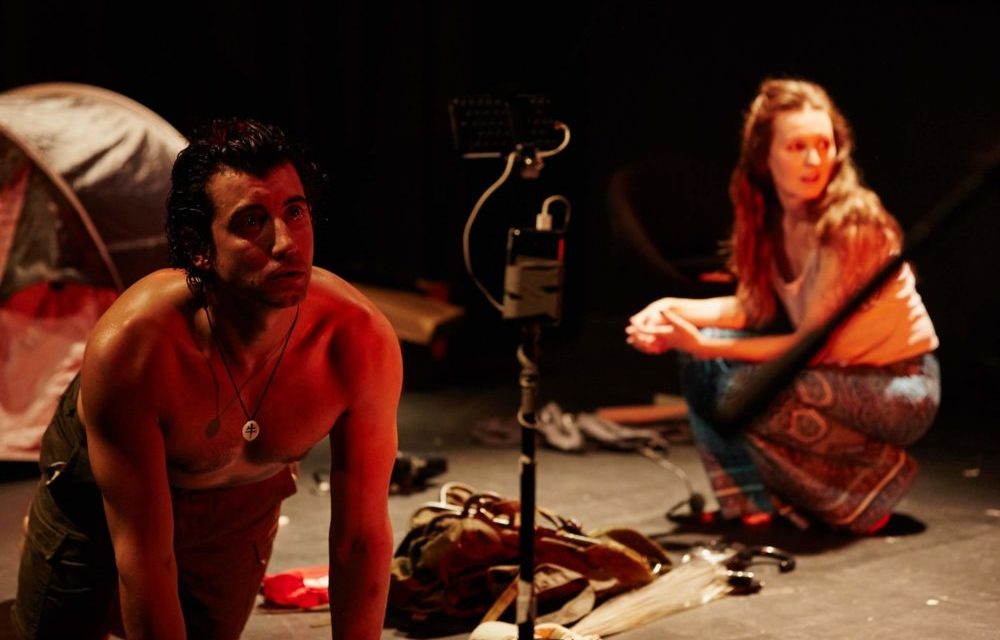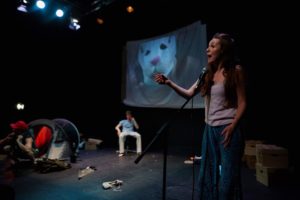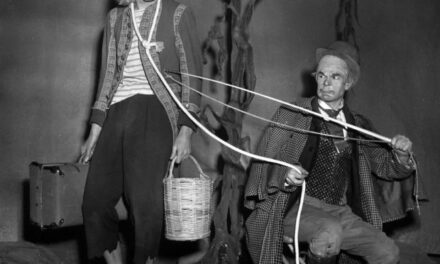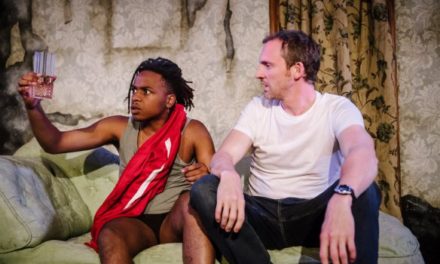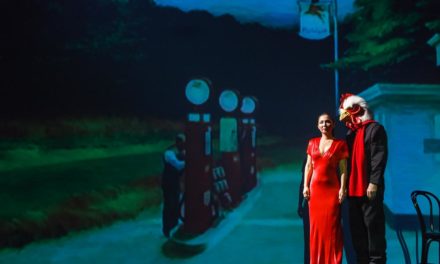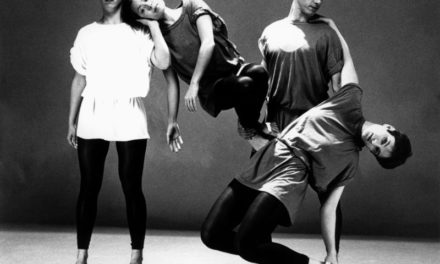The role of the dramaturg within text-based theatre is currently prescriptive and limiting. There are protocols that should be met, revolving around the axis of research and curation. Even when given priority on a production, the dramaturg is tertiary to the roles of director and playwright. Over the past decade, there has been an explosion in literature around dramaturgy and its unrealized scope. Within text-based theatre, theorists such as D.J. Hopkins, Mark Bly, and Erik Ehn have been writing prolifically on how uniquely a dramaturg can contribute to a production. Together their theories coalesce into a demand for “hybrid-authorship”, whereby the director, playwright, and dramaturg co-create a performance. Even further, Hopkins demands a space solely for the dramaturg, to which the director and playwright are attracted but cannot enter without the dramaturg’s guidance called the “counter-text.” I want to expand on these theories desbribing my particular experience as a dramaturg for Empty Deck Theatre Company and their current production, Cosmic Fear or the Day Brad Pitt Got Paranoia (2016). I will suggest that the practical application of co-creative dramaturgy posited by these theorists, exclusively enables a dramaturg to express the type of a creativity of which her role is uniquely capable.
Counter-text
When asked to define the role of the dramaturg within the theatre, Yale Co-Chair of Drama Mark Bly often refers his interlocutor to an essay called “Quantum Consciousness” by the contemporary science writer, David H. Freedman. The paper describes the life of a subatomic particle, which according to Bly, “serendipitously characterizes the life of a dramaturg in the ‘unrelentingly strange’ realm of theatre:”
Quantum mechanics is an unrelentingly strange theory. Among other things, it tells us that an electron or another denizen of the subatomic world tends to exist in a multitude of states all at once: it is simultaneously here and there, moving fast and slowly, spinning one way and the other. But at the moment the electron interacts with ordinary matter or energy–when it smacks into the molecules in a detector for example, or is bombarded by a beam of light–the disturbance somehow causes the electron to “choose” a single state.
While a static definition is often demanded of a dramaturg, Bly encourages his students of dramaturgy to be always “bristling with multiple possibilities”; that is, to become a model of creativity, appearing to overlap with other artists and their duties. This type of redundancy, he says, often leads to an increase in creativity (Bly, 54.) Theatre-makers should approach a text “as if it were a new world, free of assumptions” (Bly 314) just as a dramaturg should be allowed to exceed the “bookish drudgery” so often associated with the role.
The 2002 conference of the Literary Managers and Dramaturgs of the Americas presented a similar theme articulated by keynote speaker Erik Ehn. “The best thing a dramaturg can do is co-create, to create a conundrum as problematic as the play itself”, he said. This challenge is at significant odds with the more common assumptions about dramaturgy as a tertiary role to the director and playwright. Rather, Ehn is encouraging a new wave of dramaturgs to “creatively engage in the production process to a degree that matches the engagement of the other collaborators in the ‘hybrid authorship’ of the theatre: playwright, director, designers, actors” (Ehn 6.)
With these names around him, drama practitioner and theorist D.J. Hopkins has pioneered the notion of counter-text as an alternative site of authority and creativity for the dramaturg within the theatre. Its goal is to liberate the dramaturg within text-based theatre from one of researcher to one of creative co-authorship. Counter-text is not a ‘text’ in the sense of a written or spoken script, nor takes the form of “another” play, nor offers anything like characterization or narrative (Hopkins, 2.) Rather, it is an alternative centre of gravity that “exerts influence over the trajectory of a production process.” Ultimately, it further complicates the text and situates the performance within a wider cultural discourse. In his seminal exposition on counter-text, Hopkins refers to Ehn informally commenting that the dramaturg “creates a space that neither the writer nor director are able to enter; and to which they are both attracted” (Ehn, E-mail.) The counter-text is something that is by definition irrelevant; it is not confined by the script or bound by notions of traditional authorship. Rather it may precede or even exceed it, and provide not only supplementation but corollary (Hopkins 5.)
A Case Study
Counter-text has found recent actualisation through burgeoning practitioners, particularly those working in theatre and activism who reject agitprop expression for one that is more inclusive and objective. They have found that counter-text facilitates the complication of issues, rendering them less dichotomous and more fertile for debate.
London-based theatre company Empty Deck has embarked on a new project entitled Cosmic Fear which addresses the paralysis a Western public typically encounters when confronted with climate change. I am attached to the project in the capacity of a dramaturg and have implemented a counter-text I believe to be unique to its practice through a hybrid-authorship with artistic director, Kay Michael. I can conclude that counter-text enables text-based theatre to not only be immersive of the audience but also, unquantifiably, extends its audience impact.
The text of Cosmic Fear is written by lauded Danish-playwright, Christian Lollike. It is a veritable “panic-attack of a play”, which marks the anxious unravelling of a mind through characters A, B, and C as it ruminates on the relentlessly changing climate, and the West’s inaction to undo their devastation. Desperate, A, B and C generate film scenarios where the world is saved by Brad Pitt against various environmental backdrops.
The counter-text was born after a discussion on a Bristol-bound coach bus to the Tyndall Centre for Climate Change Research when Michael suggested we had a certain duty-of-care to the audience, reflecting on the troubling nature of the play and how it abandons its audience in a state of anxious paranoia. The idea of a talk-back was thrown around, such as that exercised by the Royal Court Theatre with Katie Mitchell’s 2071 (2014) and a ‘Day of Action’ which included a series of workshops, discussions, and lectures on how to affect personal change. We wanted more than this: we wanted action as well as a discussion that extended far beyond the theatre house, and we didn’t want sensationalism. The normative framing of climate change was already so apocalyptic and guilt-sodden, we realized we had to return to primary research and build our framework from the ground-up. We were being compelled to conceive of a new type of radical theatre. So began my work on the counter-text, with Michael suggesting I check-in every week or so with my research and direction.
I grounded my inquiry in the empirical science behind climate change, as well as psychological and social studies conducted on the UK public which collated their opinion and sentiments on the issue. My research was heavily supplemented by the primary work and secondary suggestions of Dr. Stuart Capstick, a climate change psychologist at the Tyndall Center. I was surprised to note that while the majority of the UK public observed the truth of climate change, a larger percentage of that majority admitted their inaction, and a feeling of guilt. There were many testimonials of pressure with regards to work, time and finances, with outlets such as cycling or walking vs. driving as not a realistic option; as well as prevailing self-criticisms such as, “I do feel guilty, that I don’t take enough interest in [climate change]. I probably don’t do enough…I don’t do as much as I should” (Capstick, Environmental Values). At this point, it became clear that while the majority of the public observed not only the reality of the changing climate but also their role in it, they did not possess the appropriate outlets or incentive to make sustainable lifestyle changes.
I then turned my attention to normative framings of climate change depicted in mainstream media, documentaries (both those who had gained popular traction and those which had not), and literature, finding particular aid in George Marshall’s rigorous book, Don’t Even Think About It. “I have found that everyone,” says Marshall, “experts and non-experts alike, converts climate change into stories that embody their own values, assumptions, and prejudices” (3.) What these framings manifest, and which are illustrated in the interviews conducted and data collected by Marshall, is what cognitive behavioral psychologists refer to as the three “maladaptive coping mechanisms”: avoidance, surrender, and counter-attack. These are natural reactions to the stories of climate change, that find actualisation in the points of view of climate change deniers, guilt-ridden metropolitans, or even climate change activists.
During our period of research and development, Michael also attended a conference at the University of Warwick on activism where she heard from speaker Jess Allen. Allen spoke about “slacktivism”, a long-relied on technique by activist communities to use social media campaigns and flyering as a means of public mobilization. At issue is that this technique has become tired and depersonalized, and important petitions or fundraisers join the “white noise” of the internet. As an antithesis, Allen suggests “tracktivism:” walking with a small group led by a specialist who informs and converses with them about a particular issue. A method like this is mobilizing, informative and creates community. While modest in immediate effectiveness, this concept is capable of becoming far-reaching and powerful, as its message is disseminated slowly but surely through everyone it touches; it is the growth of a steady and sturdy network through direct and personal engagement. This model became largely informative to the execution of our counter-text.
In order for Empty Deck to produce something about climate change which was new, we would not be able to present it through one of its normative frameworks as these were self-contained and often resolved in maladaptive and ineffective behavior; rather, we would reveal it as a phenomenon, encouraging non-judgmental awareness of its occurrence in order to begin from a point of common neutrality. Furthermore, we would then present flexible, tangible ways for our audience to make a change to a more sustainable and environmentally-friendly lifestyle. What would be unique about our practice is that we would be presenting a multi-level outreach program for our audience based on the cognitive behavioral psychology method of ACT (Accept, Choose, Take action.) The maladaptive coping mechanisms of avoidance, surrender and counter-attack could be pre-empted by suggestions of alternative behavior and engagement based on the model of small building blocks eventually constructing something much larger. The magnitude of what must be changed on an institutional, federal and international level is paralyzing; but to observe one’s individual responsibility and an agency is empowering. “In developed nations, almost half of all greenhouse gas emissions are tied to individual and household energy use” (Capstick, Environmental Values); 20% of greenhouse gas emissions come from the meat industry (Marshall); in the UK around 15 million tonnes of food is thrown away every year. Almost 50% of this comes from private homes (WRAP). While campaigning for our governing bodies to implement environmental sanctions is vital, our individual lifestyles are just as important in affecting change.
Cosmic Outreach
We now had the ethos of our counter-text: change on the individual level in realistic and easily-integrated ways. Our pilot would be the Edinburgh Fringe Festival, where Cosmic Fear was gaining a full run with Bedlam Theatre after our premier in the Incoming Festival in London. With a generous grant afforded to us by The Vegan Society, we had our budget. It was now a question of how to initiate our outreach program in a way that complimented our production run, and would appeal to our audience. It was time to creatively engage with our research.
My first instinct was to make direct contact with green partners in Scotland who could be interested in a skills exchange, such as bicycle repair workshops, vegan or vegetarian cooking, creative recycling or permaculture. My second initiative was to engage with green energy partners, ecologists, and national parks. Finally, I believed it was important to subsidize our activities with seminars that formally disseminated some of the research I had been conducting so that our audience not only understood the how, but the why.
I approached a variety of partners in this manner, explaining our project and its goals. Over the next two months relationships were built between myself and a list of vendors and individuals; while disappointment wasn’t absent, by the time of the counter-text’s deadline a rich and realistic outreach program had been designed. Called our Cosmic Outreach, our program features:
- Cosmic Cuisine: two vegan and vegetarian food tours around Edinburgh designed with the help of GoVeg Scotland, the Cruelty Free Guide to Edinburgh, and Ethical Voice for Animals. Our tour features ten different businesses, including Pumpkin Brown (an exclusively vegan restaurant new to the local scene), Juice Warrior (100% recyclable, organic and vegan certified cold pressed juices with nothing added) and The Caffeine Drip (a fair trade coffee shop offering vegan baked goods.)
- Cosmic Cafe: two seminars held in the cafe of Bedlam Theatre, the Fringe venue of The Cosmic Fear. The first seminar will be led by Barbara, the director of GoVeg Scotland, a wonderfully generous and informed community who campaigns for and encourages the switch to a vegan lifestyle. The second cafe will be led by Dr. Stuart Capstick where he will discuss much of the research on which our counter-text is based concerning the psychology of climate change. Bedlam’s cafe also has a vegetarian and vegan menu available.
- Cosmic Commune: an afternoon of connecting our cast to our audience, and held at Pavilion Cafe (vegetarian food and drink in The Meadows green space). The Cosmic Fear cast and crew will hold a picnic, open to the public to attend, with the invitation to join in in yoga and spoken word themed on the environment.
- Cosmic Culture: Empty Deck has partnered with Green Aspirations Scotland in Tír na nÓg Forest, a “woodland-based social enterprise” leading workshops including basket-weaving, whittling, and axe-craft. Ten audience members will have the opportunity to attend a half-day workshop on Introduction to Green Woodworking.
Utilizing the crucial research conducted by Michael and myself, by people such as Marshall, Allen and Capstick on effective activism, the counter-text promotes a community of immediate and open conversation, relinquishing the taboo around talking about climate change; it is informative and grounded in scientific inquiry, led by the expertise of Dr. Capstick; it is immersive of nature, enabling our audience to interact with the environment; and finally it is suggestive of a sustainable lifestyle that is realistically achievable. Intentionally modest and digestible, the counter-text for Empty Deck’s Cosmic Fear enables an unprecedented level of audience engagement outside of the text while simultaneously supplementing and extending it. The mechanism of the counter-text suggested by Hopkins has allowed me to creatively engage as a dramaturg with the text of play, while at once securing my role as crucial to its development.
Questioning Hybrid Authorship
Counter-text demands an equal partnership between director and playwright and dramaturg, alternative but no less authoritative and authorial. But while the process of rehearsals may be informed by the dramaturg’s counter-text, the final production may not. While the case study above illustrates a successful hybrid-authorship, often the counter-textual work of the dramaturg is subsumed or dismissed by the time of performance. This discrepancy may be understood as a result of two issues: that the traditional and embedded understanding of the role of the dramaturg is counter-productive to the notion of hybrid authorship; and Hopkins’ theory does not effectively assert the functionality of the counter-text to the quality of the production.
The function of the dramaturg has existed well before the profession itself had a name (Cattaneo 3) although its founding father is cited as G.E. Lessing writing the Hamburg Dramaturgy in the eighteenth century. Also understood as pioneers of the profession were English actors and managers John Philip Kemble and Harley Granville-Barker who reinvented the classical repertory and interpreted and adapted plays to reflect the taste of the times (Cattaneo 3.) Brecht became his own dramaturg, Polish scholar Jan Kott’s Shakespeare Our Contemporary influenced the staging of Shakespeare in a post-Beckettian world, and Kenneth Tynan’s work at The National bridged the gap between theatre and the UK public. In the 1970s Peter Stein at the Schaubuhne in Berlin evolved the concept of creative dramaturgy with Botho Strauss and Dieter Sturm, whereby the dramaturgs conceived and interpreted productions along with the director (Catteo 5.) In 1990 New Yorker author Tony Hiss wrote that the dramaturg is “someone who keeps the whole in mind” (The Experience of Place 46.) Marianne Van Kerkhoven wrote beautifully in 2007 that “dramaturgy is building bridges; it is being responsible for the whole. Dramaturgy, above all, is constant movement. Inside and outside” (165.)
While this is a very selective and succinct summary of the development of the dramaturg since the mid-1700s, it serves in establishing the role’s normative framing: one that is subsequent to and contingent on the director and playwright. With perhaps the exceptional model of Stein, Strauss, and Sturm, the dramaturg is typically understood as a research and curatorial role, providing relevant information to the director that will enhance the production, and connect it to its audience. However what the history of theory and practice around dramaturgy also indicates, is that it is a constantly fluid and developing role, flexible and contingent on the needs of the times.
Non-normative expressions of dramaturgical practice have been theorized before now. Theatre-maker Gregory Gunter has developed the process of “imaging” where a source material is generated that expands and informs the text and its production. However, as he describes, “it remains secondary to the primary authority of the text.” Similarly, Norman Frisch’s work with the Wooster Group is often relegated to one of “traffic cop who applies structure to the disorderly conduct” of all the collaborators involved in a production. While the role of the director has been liberated from the eclipsing authority of the playwright in text-based theatre, the dramaturg has yet to claim hers. Like Freedman’s subatomic particle, the dramaturg is capable of occupying many states simultaneously. It’s only when she comes into contact with the pre-established space of the director and playwright that her state is isolated and made static; her creativity is limited and her contributions curbed.
Co-creative dramaturgy as suggested by Bly and Ehn and the counter-text described by Hopkins would appear the dramaturg’s means of reaching the full scope of her potential. To be permitted hybrid authorship, to be given flexibility outside of a text to “build bridges” between the performance and the culture in creative ways can only improve the dramaturgy of a production. The director and playwright recognizing the value of creative dramaturgy is crucial in taking that step toward a fuller and richer contemporary theatre practice. However it cannot only be the responsibility of those in authoritative positions to make that change, the responsibility must also fall on the dramaturg herself.
Hopkins’ counter-textual theory at once calls itself necessary and irrelevant (3) which must not be the case. If its aim is a hybrid-authorship, then the director or playwright cannot be in the position to overrule the alternative site of authority generated by the dramaturg. My particular expression of counter-text with Empty Deck compels both director and playwright to accept its incorporation as a means of further expanding the impact and outreach of the text. This was achieved, however, by the dramaturg asserting the counter-text as inextricable from the integrity of the performance, as well as the particularly progressive mind of artistic director Kay Michael anticipating its scope. While Hopkins’ theory is progressive, he must set an example of assertion by deeming it vital to a production’s dramaturgy.
Outside of text-based theatre, the concept of the dramaturg is suspended, often along with the other titles of director or playwright. Roles are fluid and hybrid-authorship is understood as inherent to the practice. Within text-based theatre, however, there is a hierarchy, but even this has been historically dismantled, as in the director claiming authority over the text in post-dramatic theatre. Now is the time for the dramaturg to emphasize her abilities in the evolution of theatre practice and the ground has been set for her by theories such as counter-text, co-created dramaturgy, and calls-to-arms by writers such as Kerkhoven and Trencsenyi. Evolution is non-linear and unpredictable, shedding non-function for adaptation. While the dramaturg’s characteristics of research and observation remain vital, it is only a matter of time before they evolve into something more functional. The theories of hybrid-authorship and co-creative dramaturgy enable theatre practice to remain relevant not only to contemporary practitioners but also, to a contemporary audience, bringing text-based dramaturgy into the twenty-first century.
Bibliography
Bly, Mark. “Bristling With Multiple Possibilities” in Dramaturgy in American Theatre: A Source Book. Ed. Jonas, Proehl, and Lupu, pp.48-55. New York: Harcourt Brace College Publishers. 1997. Print.
Bly, Mark. “New Play Exploration in the Twenty-First Century” in The Routledge Companion to Dramaturgy. Ed. Magda Romanska. pp. 313-317. Routledge: London, 2015.
Cattaneo, Anne. “Dramaturgy: An Overview” in Dramaturgy in American Theatre: A Source Book. Ed. Jonas, Proehl, and Lupu, pp.3-15. New York: Harcourt Brace College Publishers. 1997. Print.
Capstick, Stuart. 2013. Public Understanding of Climate Change as a Social Dilemma. Sustainability. 5, 3484-3501.
Capstick, Stuart & Nicholas Pidgeon. 2014. Public perception of cold weather events as evidence for and against climate change. Climate Change. 122, 695-708.
Capstick, Stuart & Nicholas Pidgeon. 2014. What is climate change scepticism? Examination of the concept using a mixed methods study of the UK public. Global Environmental Change 24, 389-401.
Capstick, Stuart, Lorraine Whitmarsh, Wouter Poortinga, Nick Pidgeon, and Paul Upham. International trends in public perceptions of climate change over the past quarter century. WIREs Climate Change 2015, 6:35–61.
To cite this article: Stuart Capstick, Irene Lorenzoni, Adam Corner & Lorraine Whitmarsh (2015): Prospects for radical emissions reduction through behavior and lifestyle change, Carbon Management.
Ehn, Erik. “Stuffing for This Pillow: Dreamturgy recalled” [sic]. Keynote Address. Literary Managers and Dramaturgs of the Americas Annual Conference. Simon Fraser University. Vancouver. 12 June 2002.
Frisch, Norman, and Marianne Weems. “Dramaturgy on the Road to Immortality: Inside the Wooster Group” in Dramaturgy in American Theatre: A Source Book. Ed. Jonas, Proehl, and Lupu, pp.483-503. New York: Harcourt Brace College Publishers. 1997. Print.
Hopkins, D.J., Research, ‘Counter-text, Performance: Reconsidering the (Textual) Authority of the Dramaturg.” Theatre Topics, 2003, Vol. 13(1), pp. 1-17 [Peer Reviewed Journal.]
Jess Allen, University of Manchester: Tracking tracktivism: reflections on walking a neologism into the field (of activist performance).
Kerkhoven, Marianne Van. “European Dramaturgy in the twenty-first century: a constant movement” in The Routledge Companion to Dramaturgy. Ed. Magda Romanska. pp. 163-167. Routledge: London, 2015.
Marshall, George. Don’t Even Think About It. New York: Bloomsbury USA. 2014. Print.
Reposted from The Empty Deck Theatre Company blog by permission of the autor.
This post was written by the author in their personal capacity.The opinions expressed in this article are the author’s own and do not reflect the view of The Theatre Times, their staff or collaborators.
This post was written by Lucy Rose Coren.
The views expressed here belong to the author and do not necessarily reflect our views and opinions.

